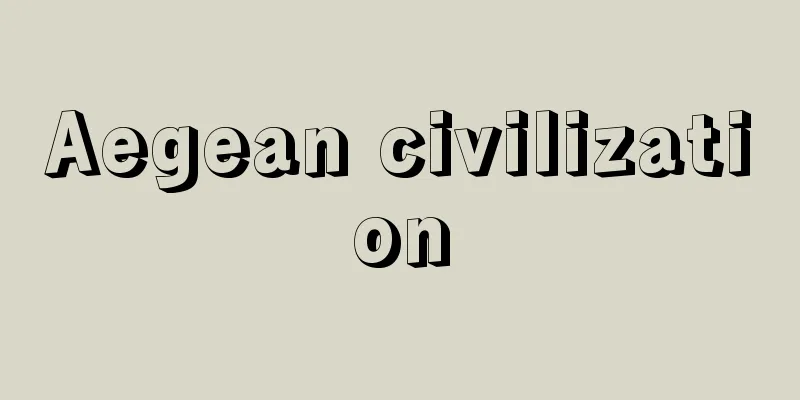Aegean civilization

|
An ancient civilization that flourished in the Aegean region in the eastern Mediterranean. This region has a warm Mediterranean climate, with clear air and safe navigation without losing sight of the islands, which connected it to the advanced Oriental culture by maritime traffic and allowed it to develop an advanced culture much earlier than other parts of Europe. Just as its geographical location served as a bridge for the spread of culture at the point of contact between Asia and Europe, the Aegean civilization is historically and character-wise positioned between the Oriental and European civilizations. Non-Aryan peoples of Asia Minor began settling in the Aegean region around 3000 BC, at the end of the Neolithic period, and from around 2600 BC, the Early Bronze Age culture arose in Crete, the Cyclades, Mycenae and other parts of the southern Greek mainland, and Troy in Asia Minor. The Cyclades in particular prospered as a transit point for maritime traffic, and produced pottery with spiral patterns called "frying pans" and marble idols, whose simple abstract forms have a freshness that is reminiscent of modern sculpture. The use of metals was already evident around 3000 BC, with statuettes and ornaments made from electrum (an alloy of gold and silver), gold, copper, and bronze. Sturdy buildings were also built from cut stone and fired brick, and were often decorated with reliefs and murals. Then, during the Middle Bronze Age, artistic activity in Crete and Mycenae also developed rapidly, but was destroyed around 1200 BC by the Dorians who moved south from the north. The existence of the Aegean civilization was completely unknown until the mid-19th century, but from the end of the 19th century to the beginning of the 20th century, a series of excavations were carried out in various places, including those at Troy and Mycenae by Schliemann and at Knossos on Crete by Evans, and its details gradually became clearer. In recent years, the excavations on the island of Santorini (ancient name Thera) by Marinatos, which began in 1967, have attracted attention for the large number of murals that have been unearthed. Even today, excavations and research are continuing by archaeologists from Greece, Britain, France, Italy, and other countries. Aegean civilization is broadly divided into a southern culture represented by Crete and a northern culture represented by Mycenae. [Nao Tomobe] CreteCrete is a large island at the southern end of the Aegean Sea, and had early contact with the Orient and Egypt. Its inhabitants are thought to be a mixture of the Mediterranean race and Asia Minor. During the Neolithic Age, the island opened up from the eastern part of the island, and politics, military affairs, and art made rapid progress, leading to a monopoly on trade in the eastern Mediterranean. Around 2000 BC, one king established control over the entire island. Large palaces were built in Knossos, Malia, Phaestos, and Zakuro, and the production of pottery and metalware flourished, and small sculptures and paintings developed. It is also called the Minoan civilization after the name of this legendary king, Minos. Around 1700 BC, palaces in various places collapsed due to a disaster that was probably caused by volcanic ashfall and a major earthquake, but new, larger palaces were soon rebuilt. The Cretan civilization reached its peak in the nearly two centuries that followed. In particular, the capital, Knossos, prospered as a political and economic center, with a population of 80,000 according to Evans' estimate. The excavation of Knossos, which began in 1900, proved the prosperity of Crete, as described by Homer in the Odyssey as "Knossos, the great city, where King Minos reigned nine years." The palace was built on a gentle hill and had a rectangular courtyard, around which were arranged rooms for ceremonies and public affairs, private rooms for the royal family, workshops, and storehouses, with careful attention paid to lighting and drainage. A narrow passageway made several right-angle turns before reaching the entrance. This complex plan is probably why the palace of Knossos came to be called a labyrinth. Palaces in other regions vary in size, but the plan and style share common characteristics with Knossos. The main rooms of the palace of Knossos are decorated with colorful murals, which are noteworthy as unique works in the history of ancient painting. The main pieces include fragments of murals depicting young women called "Bull-Leaping," "Youth with a Lily Crown," and "Parisienne." A distinctive feature of Cretan art is that it did not leave behind large sculptures like Egypt and Greece, but was instead interested in small, familiar, everyday objects. Horn-shaped cups called rhytons shaped like bull's heads, ivory statues of snake goddesses, Basiliki pottery which makes use of the markings created during firing, and Kamares-style black pottery with a beak-shaped spout are all decorated with motifs typical of maritime peoples, such as fish, shells, and octopuses, as well as peoples' figures, plants, and spirals. Large jars called pithos were also made to store wine and olive oil. Personal ornaments include golden bee pendants and rings. Although much remains unknown about the religion and language of the time, Evans pointed out that the Aegean civilization had some kind of writing, which he classified into hieroglyphic A, B, Linear A, and B. In 1952, British scientist Michael Ventris succeeded in deciphering Linear B, which enabled us to infer to some extent the administrative organization and social conditions of the time. According to his work, linen textiles and wine were exported, and there was also a high demand for armor and wheelbarrows. Tin, which was used to make bronze products, and alum, a mordant for dyeing, were imported. The lifestyle and culture thus estimated is quite close to the world depicted by Homer. Crete was destroyed by an invasion from the Greek mainland around 1400 BC, and palaces in Knossos and other places were destroyed, the population was dispersed, and the center of Aegean civilization moved to Mycenae. [Nao Tomobe] SantoriniAt the same time as the Cretan civilization, a Late Bronze Age culture flourished on Santorini, a small volcanic island at the southernmost tip of the Cyclades. There was once a large town on the island, but around 1500 BC, a major eruption blew away most of the island. The crater became a bay, and the surrounding mountain rim is the current land. Greek archaeologist Marinatos speculated that the volcanic eruption on Santorini caused an earthquake and tsunami of unimaginable scale, which also damaged Crete and caused the demise of the Cretan civilization. He began excavation work on Santorini in 1967. As a result, a large group of houses buried in ash was discovered in Akrotiri, at the southern tip of the island, and people were surprised by the discovery of new facts far beyond their expectations. The interiors of these houses are decorated with magnificent murals, frescoed in the same style as those in Crete, but in much better condition than those in Crete. The motifs are landscapes on and off the coast, flowers, grasses, animals, and people. The mural, named "Spring Fresco," is a lyrical work depicting lilies and swallows blooming on a rocky mountain, evoking the Santorini people's view of nature, while the "Boxing Boy," "Fisherman," and "Lady Figure" give insight into the customs of the time. The seven-meter-long "Boat Procession" depicts a fleet of ships sailing in formation on the sea, with people on land watching them off, making it a valuable work for learning about the structure and navigation of boats at the time. In addition to the murals, pottery, stone tools, lamps, and bronze tools have been excavated from the Akrotiri ruins, some of which are thought to be Cretan products. Excavations on Santorini are continuing, but no human bones or precious metals have been found so far, and it is assumed that people evacuated the island before the final eruption. [Nao Tomobe] Greek mainlandWhile the Cretan civilization was developing into an advanced Bronze Age civilization centered around Knossos, the early Helladic culture was in existence on the Greek mainland. Between 2000 and 1600 BC, northern Indo-European peoples moved south through the Balkans, conquered the indigenous peoples, and settled all over Greece, mainly in the Peloponnese. They were called the Achaeans, and established small kingdoms in various parts of the southern part of the mainland, including Mycenae, Tiryns, Orchomenos, and Pylos. The most powerful of these was the Mycenaean kingdom of the Atreus family, which became the central force on the mainland, coming into contact with and accepting the advanced Cretan civilization, and eventually destroying Crete by force and dominating the Aegean Sea. The Mycenaean civilization reached its zenith between the end of 1600 and 1400 BC, and its royal palace and excavated items best show the characteristics of Mycenaean art. Schliemann began excavating the ruins of Mycenae in 1874, following Troja, and in 1876 he discovered the body of a man wearing a gold mask and numerous treasures in a huge circular tomb surrounded by two stone slabs inside the famous Lion Gate, reviving the "gold-rich Mycenae." The remains of the royal palace were built on the Acropolis, a small hill with a rocky backdrop, and in contrast to the openness of the Cretan palace, it had more of a fortress character than a royal palace. This can also be seen in the Lion Gate, which served as the main gate. Mycenaean art is also characterized by the magnificent vaulted tombs built outside the Acropolis. The most famous of these, the "Treasury of Atreus," consists of a shrine chamber with a 14.5-meter dome and a mortuary chamber at the back, demonstrating the high level of architectural technology at the height of the Mycenaean period. Mycenaean art was heavily influenced by Cretan art, but there are also some fundamentally different characteristics between the two. In terms of architecture, many palaces in Crete were built on relatively flat ground, were open buildings decorated with gorgeous murals, and tended to enjoy bright and comfortable daily life, but in Mycenae, the palaces were fortresses surrounded by huge walls. Facing the palace courtyard was a rectangular main room called a megaron, with four columns, surrounded by thick walls, and a hearth in the center. This simple megaron style became the prototype for later Greek temple architecture. The huge lion relief placed at the main gate of the castle is also not seen in Crete. While Cretan art is open, naturalistic, feminine, and pictorial, Mycenaean art is closed, geometric, masculine, and emphasizes representation of authority. It is during this period that themes with human figures, soldiers, and battle scenes appear on pottery. After 1400 BC, Mycenaean civilization began to show signs of gradual decline, and the construction of large tombs was no longer observed. The Dorians, who brought iron tools from the north, moved south, and around 1100 BC, this wave of ethnic migration led to the collapse of the once glorious Mycenae and other cities, bringing the Aegean civilization to an end. Greece entered a dark age until the Archaic period began in the 8th century BC. [Nao Tomobe] "World Art Series 4: Aegean Art" edited by Murata Kazunosuke (1962, Kodansha) " "World Art Series 4: Ancient Mediterranean Art" edited by Shinya Norio (1976, Gakken) " "Orient and Aegean Art" by W. Wols, translated by Tomobe Naoyuki (1979, Graphic-sha) ©Shogakukan "> Periodization of the Aegean civilization ©Shogakukan "> Distribution of Aegean civilization ruins The ruins of the palace believed to be the residence of the legendary King Minos. Construction began around 2000 BC, but it collapsed around 1700 BC and was immediately rebuilt. Most of the existing remains are from this new palace. The photo shows the colonnade at the north entrance to the palace. Near Heraklion, Greece ©Shogakukan "> Knossos Palace Ruins The remains of a palace built around 2000 BC. Along with Knossos, it is one of the most representative ruins of the Minoan civilization. Crete, Greece ©Shogakukan "> Maria Palace Ruins The main gate of Mycenae, surrounded by the city walls. In the style of Cretan architecture, two lions facing each other are carved in relief (their heads are missing). The height of the opening is about 3m. Part of the World Heritage Site "Archaeological Sites of Mycenae and Tiryns" (Greece, registered in 1999) Greece, Peloponnese ©Shogakukan "> The Lion Gate, ruins of Mycenae Lyre player. 2800-2700 BC (Cycladic culture) Marble Height 29.21 cm Collection of the Metropolitan Museum of Art, Greece"> Marble statuette Source: Shogakukan Encyclopedia Nipponica About Encyclopedia Nipponica Information | Legend |
|
地中海東部のエーゲ海周辺地域に栄えた古代文明。この地域はいわゆる地中海型の温暖な気候で、空気が澄み、島影を見失わずに安全に航海することができたから、先進のオリエント文化圏と海上交通で結ばれ、ヨーロッパの他の地域よりはるかに早く高度の文化が開けた。その地理的位置がアジアとヨーロッパの接点で文化伝播(でんぱ)の橋の役割を果たしたように、エーゲ文明は歴史的にも性格的にもオリエントとヨーロッパ文明の中間に位置している。 エーゲ海周辺地域には紀元前3000年ごろの新石器時代末から非アーリア系の小アジア人が定住し始め、前2600年ごろから、クレタ島、キクラデス諸島、ミケーネをはじめとするギリシア本土南部、小アジアのトロヤなどに初期青銅器文化が興った。とくにキクラデス諸島は海上交通の中継地として繁栄し、「フライパン」とよばれる渦文装飾の土器や大理石の偶像がつくられたが、その単純な抽象的形態は現代彫刻に通じる新鮮さがある。金属の使用は前3000年ごろすでにみられ、エレクトラム(金と銀の合金)や金、銅や青銅などによる小像や装身具がつくられた。また、切り石や焼成れんがによる堅固な建物がつくられ、しばしば浮彫りや壁画で飾られた。ついで中期青銅器時代に入ると、クレタやミケーネの芸術活動も飛躍的に発展したが、前1200年ごろ、北方からのドーリア人の南下によって滅んだ。 エーゲ文明の存在は19世紀中ごろまでまったく知られていなかったが、19世紀末から20世紀初頭にかけてシュリーマンによるトロヤ、ミケーネの発掘、エバンズによるクレタ島クノッソスの発掘をはじめ各地の発掘が相次ぎ、その様相がしだいに明らかになってきた。近年では、1967年に始まるマリナトスによるサントリーニ(古代名テラ)島の発掘によって、多くの壁画が出土したことが注目される。今日でもギリシアをはじめイギリス、フランス、イタリアなどの考古学者によって発掘・研究が続けられている。 エーゲ文明はクレタ島に代表される南方系の文化と、ミケーネに代表される北方系の文化に大別される。 [友部 直] クレタ島クレタ島はエーゲ海の南端にある大きな島で、早くからオリエント諸地域やエジプトと交流があった。住民は地中海人種とよばれる種族に小アジア人が混血したものと考えられる。新石器時代に島の東部から開け、政治、軍事、芸術は急速に進歩し、東地中海の交易権を独占するようになった。前2000年ごろ1人の王による全島の支配が確立された。クノッソスをはじめマリア、フェストス、ザクロなどに大宮殿が造営され、陶器、金属器の製作が盛んになり、小さな彫刻や絵画が発達した。この伝説的な王の名「ミノス」にちなんで、「ミノス文明」ともよばれる。前1700年ごろ、おそらく火山活動に伴う降灰と大地震と思われる災害によって各地の宮殿は倒壊したが、まもなく、より大規模な新宮殿が再建された。この後のほぼ2世紀がクレタ文明の絶頂期である。とくに首都クノッソスは、エバンズの推定によれば人口8万を数え、政治、経済の中心として繁栄した。1900年に始まったクノッソスの発掘は、ホメロスが『オデュッセイア』のなかで「大いなる街クノッソス。ミノス王が9年の間統治した」というクレタの繁栄を実証することになった。その宮殿はなだらかな丘の上に展開し、長方形の中庭をもち、それを囲んで祭儀や公務のための室、王族の私室、工房、倉庫が配置され、採光や排水にも留意されていた。狭い通路は何度か直角に曲がって入口に達するようになっている。このような複雑なプランをもつことから、クノッソス宮殿は「迷宮」(ラビリントス)とよばれることになったのであろう。他の地域の宮殿も大小の差はあるが、プラン、様式ともクノッソスと共通した性格が認められる。クノッソス宮殿のおもな室は色彩鮮やかな壁画で飾られ、古代の絵画史のなかで特異な作品として注目される。おもなものに「牛跳び」「ユリの冠の若者」、「パリジェンヌ」とよばれる若い女性像の壁画断片がある。クレタ美術の特色は、エジプトやギリシアのように巨大な彫刻を残さなかったことであり、彼らは日常的で小さく親しみあるものに興味をもった。牛の頭部をかたどったリュトンとよばれる角状杯、象牙(ぞうげ)の蛇女神像、焼成の際の斑紋(はんもん)を生かしたバシリキ陶器、カマレス式とよばれる嘴(くちばし)状の注ぎ口をもつ黒地の陶器には、人物、草木、渦巻のほか、魚や貝、タコなど海洋民族らしいモチーフが描かれている。ぶどう酒やオリーブ油を貯蔵するピトスとよばれる大甕(おおがめ)もつくられた。装身具では黄金のハチのペンダントや指輪がある。 当時の宗教および言語についてはまだ不明な点が多いが、エーゲ文明がある種の文字をもっていたことはエバンズが指摘しており、象形文字A、同B、線文字A、同Bに分類した。1952年イギリスのマイケル・ベントリスが線文字Bの解読に成功し、それによって、当時の行政組織や社会状態をある程度まで推測できるようになった。それによると、麻織物やぶどう酒が輸出され、鎧(よろい)や一輪車の需要も大きかった。青銅品をつくる錫(すず)や染物の媒染剤のミョウバンが輸入されている。こうして推定される生活文化は、ほぼホメロスの描く世界に近い。クレタは前1400年ごろギリシア本土からの侵入によって滅び、クノッソスはじめ各地の宮殿は破壊され住民は四散して、エーゲ文明の中心はミケーネに移った。 [友部 直] サントリーニ島クレタ文明と同時期に、キクラデス諸島の最南端の小さな火山島、サントリーニ島にも青銅器時代後期の文化が栄えた。かつてこの島には大きな町があったが、前1500年ごろ大噴火によって島の大半が吹き飛んだ。噴火口にあたる部分は湾になり、それを囲む外輪山が現在の陸地になっている。ギリシアの考古学者マリナトスは、サントリーニ島の火山爆発が想像を絶する規模の地震と津波をおこし、それがクレタ島にも被害をもたらし、クレタ文明滅亡の原因となったと推測した。そして、1967年にサントリーニ島の発掘調査を始めた。その結果、島の南端アクロティリから灰にうずもれた大家屋群が発見され、予想をはるかに超える新事実の発見となって人々を驚かせた。これらの家屋の内部はみごとな壁画で飾られ、それらはクレタと同じ手法のフレスコ画であるが、クレタよりも保存状態ははるかによい。モチーフは海上・陸上の風景、花や草、動物、人物などで、「春のフレスコ」と名づけられた壁画は岩山に咲き乱れるユリの花とツバメを描いた叙情的な作品で、サントリーニの人々の自然観を思わせ、「ボクシングの少年」「漁師」「婦人像」などからは当時の風俗を知ることができる。また長さ7メートルに及ぶ「舟行図」では隊列を組んで海上を行く船団と、それを見送る陸上の人物が描かれ、当時の舟の構造や操船法を知るうえで貴重な作品である。壁画以外にも、アクロティリ遺跡から土器、石器、ランプ、青銅器などが出土し、なかにはクレタの製品と思われるものもある。サントリーニ島の発掘調査は続けられているが、いままでのところ人骨や貴金属類が発見されておらず、人々は最終的な大噴火の前に島を避難したものと想像されている。 [友部 直] ギリシア本土クレタ文明がクノッソスを中心に高度の青銅器文明を開花させていたころ、ギリシア本土では初期ヘラディック文化があったが、前2000年から前1600年にかけてインド・ヨーロッパ語系の北方民族がバルカン半島を南下し、先住民族を征服して、ペロポネソス半島を中心にギリシア各地に定住した。彼らはアカイア人とよばれ、本土南部の各地に小王国を建設した。ミケーネ、ティリンス、オルコメノス、ピロスなどがそのおもなものである。このうちもっとも強大だったのがアトレウス家のミケーネ王国で、本土の諸勢力の中心的存在となり、先進のクレタ文明に接してこれを受け入れるとともに、ついには武力でクレタを崩壊させ、エーゲ海に君臨した。 ミケーネ文明は前1600年末から前1400年にかけて絶頂期に達し、その王宮と出土品はミケーネの美術の特質をもっともよく示している。ミケーネの遺跡は、シュリーマンがトロヤに次いで1874年に発掘を始め、76年に有名な獅子門(ししもん)の内側にある二重の石板で囲まれた巨大な円型墳墓から黄金のマスクをつけた男性の遺体や数々の財宝を発見し、これによって「黄金に富めるミケーネ」をよみがえらせた。王宮の遺構は岩山を背に小高い丘アクロポリスの上に築かれ、クレタ宮殿の開放性とは対照的に、王宮というより城塞(じょうさい)としての性格が強いものであった。それは主門としての獅子門にもみることができる。アクロポリスの城外に築かれた壮大な穹窿(きゅうりゅう)墓群もミケーネ美術を特徴づけるもので、もっとも有名な「アトレウスの宝庫」は、直径14.5メートルのドームからなる祭室と奥の遺体安置室で構成され、ミケーネ時代最盛期の建築技術がいかに高い水準をもっていたかを物語っている。 ミケーネ美術にはクレタ美術の影響が濃厚にみられるが、両者の間には本質的に異なるいくつかの特色もみられる。建築ではクレタの多くの宮殿は比較的平坦(へいたん)な土地に建てられ、華やかな壁画で彩られた開放的な建物で、明るく快適な日常生活を楽しむ傾向が著しいが、ミケーネでは、宮殿は巨大な城壁で囲まれた砦(とりで)であった。宮殿の中庭に面してメガロンという長方形の主室があり、4本の柱が立ち、周囲を厚い壁で囲まれ、中央に炉が仕切られていた。この簡素なメガロン様式は後のギリシアの神殿建築の原型となった。城の正門に置かれた巨大な獅子の浮彫りもクレタにはみられないものである。 クレタ美術が開放的で自然主義的、女性的、絵画的であるとすれば、ミケーネ美術は閉鎖的で幾何学的、男性的で権威表象性を重視している点に特色がある。陶器の文様に人物を主題としたテーマ、兵士や戦闘場面などが現れてくるのもこの時代に入ってからである。 前1400年以後、ミケーネ文明はしだいに衰退の兆しをみせ始め、巨大な墳墓の造営はみられなくなる。北方から鉄器をもったドーリア人が南下し、その民族移動の波を受けて、前1100年ごろには、栄華を誇ったミケーネをはじめとする諸市は崩壊し、エーゲ文明は終わりを告げる。アルカイック期が始まる前8世紀ごろまで、ギリシアは暗黒の時代に入るのである。 [友部 直] 『村田数之亮編『世界美術大系4 エーゲ美術』(1962・講談社)』▽『新規矩男編『大系世界の美術4 古代地中海美術』(1976・学習研究社)』▽『W・ヴォルス著、友部直訳『オリエント・エーゲ海美術』(1979・グラフィック社)』 ©Shogakukan"> エーゲ文明の時代区分 ©Shogakukan"> エーゲ文明の遺跡分布 伝説の王ミノスの居城とされる宮殿の遺跡。建造は紀元前2000年ごろに始まったが、紀元前1700年ごろに崩壊後ただちに再建。現存の遺構の大部分は、この新宮殿のものである。写真は宮殿の北入口の柱廊。ギリシア イラクリオン近郊©Shogakukan"> クノッソス宮殿跡 紀元前2000年ごろに造営された宮殿の跡。クノッソスなどとともに、ミノス文明を代表する遺跡である。ギリシア クレタ島©Shogakukan"> マリア宮殿跡 城壁をめぐらしたミケーネの正門。クレタ建築の形式で、向き合った2頭の獅子が浮彫りされている(頭部は失われている)。開口部の高さは約3m。世界文化遺産「ミケーネとティリンスの古代遺跡群」の一部(ギリシア・1999年登録) ギリシア ペロポネソス半島©Shogakukan"> ミケーネの遺跡「獅子門」 竪琴奏者。紀元前2800~前2700年ころ(キクラデス文化) 大理石 高さ29.21cm ギリシアメトロポリタン美術館所蔵"> 大理石の小像 出典 小学館 日本大百科全書(ニッポニカ)日本大百科全書(ニッポニカ)について 情報 | 凡例 |
>>: Egeyama ruins - Egeyama ruins
Recommend
monic
… When all the monomials appearing in f ( x1 , .....
Ammophila atripes japonica (English spelling) Ammophilaatripesjaponica
…[Shiro Katsuya]. . . *Some of the terminology th...
Bluebird - bluebird
A general term for birds in the genus Sialia, fam...
Peireshia aculeata (English spelling)
…They grow mainly in the tropical rainforests of ...
The Record of Plays - Kezairoku
A document on Kabuki. Written by Nyugatei Ganyu. ...
Conant, James Bryant
Born March 26, 1893 in Dorchester, Massachusetts [...
Diomedea albatrus (English spelling)
…[Hiroshi Aramata]. … *Some of the terminology th...
Akashino
...The main types of ware are tea ware such as te...
Kamiyagawa River
A river that flows south through the western part...
Diagonal weave - Nanakoori
The name comes from the use of seven twisted threa...
New book - Shinsho
A common name for small books slightly larger than...
Khorāsān (English spelling)
The name of a region stretching from Iran to Afgha...
Laparotomy - Healing
〘 noun 〙 To cut open the abdomen in order to perfo...
Respondent conditioning
…In both of these, the association of two process...
Western Samoa (English spelling)
…Official name: Independent State of SamoaArea: 2...




![Futtsu [city] - Futtsu](/upload/images/67ccb74308f6e.webp)




